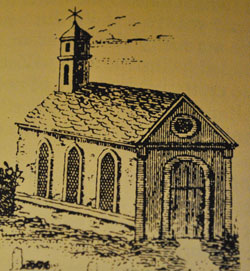
There were certain rites of passage marked by colonial churches—birth, initiation, marriage, and death for the great majority of its white population and to lesser and varying extents for non-adherents and African Americans as well. We will look at the third one this week – Marriage.
In the 1662 prayer book its was called the “Solemnization of Matrimony."
Unlike the Catholics, the Anglicans rejected marriage as a sacrament but ascribed greatest importance to it in very direct language. First it was “ ordained for the procreation of children.” Secondly “, It was ordained for a remedy against sin, and to avoid fornication; that such persons as have not the gift of contingency might marry, and keep themselves undefiled members of Christ’s body.” Thirdly “It was ordained for the mutual society, help, and comfort, that the one ought to have of the other, both in prosperity and adversity. “ Marriage was a "holy estate."
As in England, legal authorization for a man and a woman to marry could be obtained by one of two means. The couple might apply through the county clerk for a license, the clerk in this instance serving as the governor’s deputy. The advantage of the license was its minimal waiting period, but the hefty fees and the posting of a bond put this out of reach for most Virginians. Publication of barms in the parish church was the alternative utilized by most.
On three successive Sundays, the parson or, more likely, the parish clerk announced at the appointed time during or following the service: "I publish the Banns off Marriage between M. of and N. … If any of you know cause, or just impediment why these two persons should not be joyned together in holy Matrimony, you are to declare it." If the man and the woman lived in different parishes, banns were announced in both. For this task, parsons or clerks received a fee
The language of banns made obvious the purpose of ensuring the lawfulness of the intended union
Among mutual concerns, age was central. To guard against precipitous or unwise decisions, anyone under twenty-one years of age had to secure the permission of parents or guardian. Licensing or banns also sought to protect against marriages that might violate the rules of consanguinity. To this concern with blood relationship, Virginia civil authorities, like their counterparts in other colonies into which African slaves had been introduced, added prohibitions of racial intermarriage.
Weddings in Virginia were a monopoly of the Anglican church. Parsons alone could officiate. At the time the canonical requirement that weddings be performed between the hours of 8 and 12 in the morning. By Canon law, weddings were prohibited during Lent and Advent. However, there were numerous exceptions made.
Like with baptisms, practice among gentry families was to hold the wedding at their home rather than the church. Church rubrics were explicit: weddings were to be performed "not in any private Place" but in a church where one of the parties "dwelieth" and "in the time of Divine Service."
Marriage records have survived mostly from the eastern parts of Virginia but not the back country. When population exploded after 1730 and when people came from outside rather than from home Anglican churches, there were more deviation in the above – more common -law marriages.
